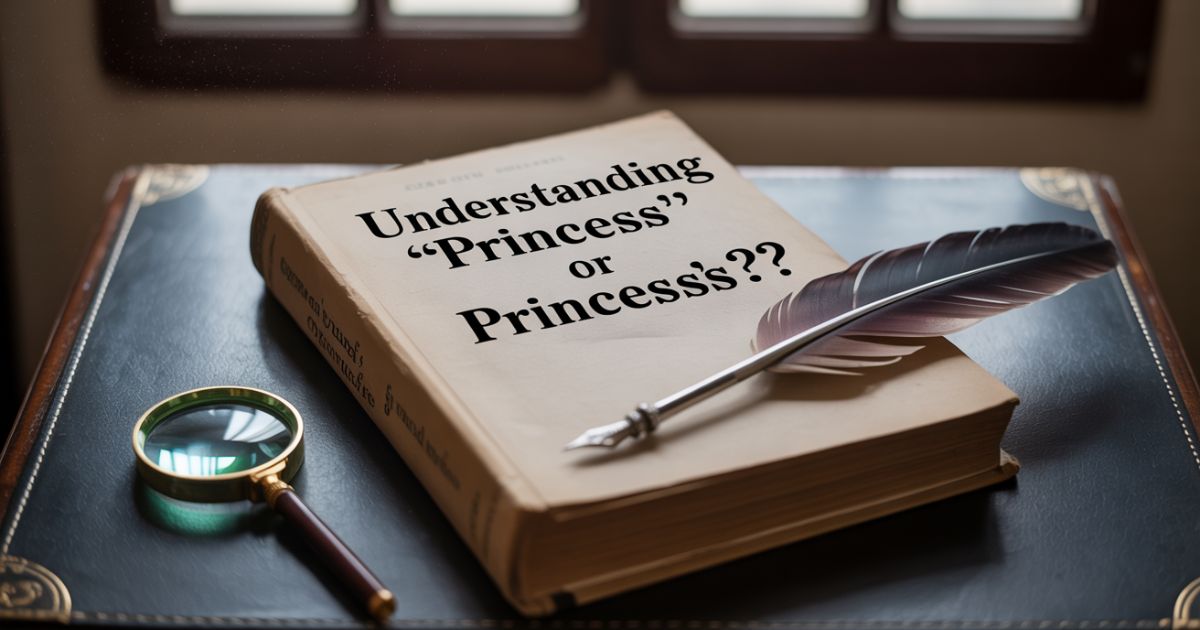English is a beautiful, nuanced language but let’s be honest: it can be really confusing sometimes. One area that continues to trip people up, even well into adulthood, is possessive punctuation, especially when it involves names or nouns that already end in “s.”
Take the word “princess,” for example. Should it be written as princess’ or princess’s when showing possession? If you’ve found yourself staring at the screen and second-guessing which one is correct, you’re definitely not alone.
In this article, we’ll break down the difference between princess’ and princess’s, explain when to use each, and give you real-life examples so you can master this tricky topic once and for all.
What’s the Difference Between “Princess’” and “Princess’s”?
Both “princess’” and “princess’s” are possessive forms of the noun princess. That means they both can be used to show ownership or relationship to something else.
But here’s the catch: Which one you use often depends on a style guide or pronunciation preference.
- Princess’s is the more traditional form and is accepted in most modern style guides.
- Princess’ is often used in journalistic writing or when trying to avoid awkward-sounding possessives.
So technically, both can be correct, but there’s a bit more nuance depending on who your audience is and how formal your writing needs to be.
The Rule of Thumb
When in Doubt, Add ’s
Most grammar experts—including those behind the Chicago Manual of Style—agree that you should generally add ’s to form the possessive, even when the word already ends in “s.”
So for the word princess, the possessive form would usually be written as:
The princess’s gown shimmered in the moonlight.
Even though princess already ends in “s,” we still add ’s to show possession.
When to Use “Princess’s”
Use princess’s when you are following modern grammar rules and pronounce the possessive as an extra syllable.
Let’s take a look at a few examples:
- “The princess’s tiara was encrusted with diamonds.”
- Here, we are talking about the tiara belonging to the princess.
- “I was reading a story about the princess’s dragon.”
- The dragon belongs to the princess in this case.
Notice that you would pronounce these as “prin-cess-iz,” with a soft “iz” sound at the end. That’s a good sign that adding the ’s is both natural and correct.
When to Use “Princess’”
Now, there are some exceptions and stylistic preferences that call for just the apostrophe at the end—princess’.
This form is usually used when:
- You’re following Associated Press (AP) style, which is common in journalism.
- The word sounds awkward or clunky with the extra “’s”.
- You’re dealing with classical names or titles (e.g., Jesus’ teachings, Moses’ staff).
Here are a few scenario-based examples:
- “The princess’ palace was the largest in the kingdom.”
- This might appear in a newspaper headline or article, where brevity and style are prioritized.
- “We admired the princess’ speech from afar.”
- Again, this might be an editorial decision for cleaner rhythm.
The key takeaway here is that both are technically correct, but princess’s is more grammatically consistent, while princess’ leans into stylistic brevity.
A Quick Analogy: Other Similar Words
If you’re still not sure, it helps to look at other nouns that end in “s” and how we treat their possessive forms.
Let’s compare a few:
| Noun | Possessive Form (Preferred) | Example |
|---|---|---|
| Boss | Boss’s | The boss’s car is in the lot. |
| Class | Class’s | The class’s presentation was great. |
| Actress | Actress’s | The actress’s role was demanding. |
| Princess | Princess’s | The princess’s smile was radiant. |
As you can see, we almost always add ’s, even when the noun ends in “s.” So unless you’re working under a style guide that says otherwise, you’re safer using princess’s.
Choosing Based on Sound and Style
Sometimes it just comes down to how it sounds when you say it out loud.
Read it out loud:
- “The princess’s sandals were missing.” → Natural
- “The princess’ sandals were missing.” → Slightly more abrupt
If the extra “iz” sound doesn’t feel awkward, then go with ’s. But if you find yourself tripping over the sentence rhythm, or if your audience leans toward journalistic or AP style, it’s okay to use just the apostrophe.
Common Mistakes and How to Avoid Them
Let’s go over some common errors people make with words like princess:
❌ Mistake #1: Confusing plural with possessive
- Incorrect: The princesss were all in attendance.
- Correct plural: The princesses were all in attendance.
- Correct possessive: The princess’s speech was inspiring.
The plural of princess is princesses, not princesss, and the possessive needs an apostrophe.
❌ Mistake #2: Skipping the apostrophe altogether
- Incorrect: The princess crown is missing.
- Correct: The princess’s crown is missing.
Always use an apostrophe to show ownership.
❌ Mistake #3: Inconsistent usage
Switching between princess’s and princess’ in the same piece of writing can be jarring. Pick one style and stick to it throughout your document.
Final Thoughts: Which One Should You Use?
To wrap it all up:
- Use princess’s when following traditional and most academic or professional style guides (like Chicago or MLA).
- Use princess’ if you’re writing in AP style or prefer a cleaner look without the extra syllable.
- Read your sentence out loud to check how it sounds—natural rhythm often leads to the best choice.
If you’re ever unsure and there’s no style guide telling you otherwise, it’s safest to stick with:
The princess’s gown was breathtaking.
Simple. Clear. Correct.
One Last Tip
Still unsure in the moment? Try rephrasing the sentence to avoid the possessive altogether:
Instead of:
“The princess’s horse galloped across the field.”
Try:
“The horse of the princess galloped across the field.”
This trick can help you sidestep the grammar dilemma entirely—especially when writing quickly or under pressure.


